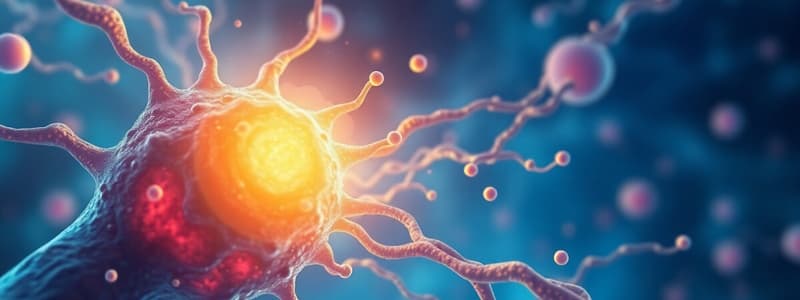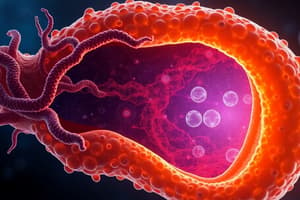Podcast
Questions and Answers
Which of the following is the primary role of SNAP-25 in vesicle fusion?
Which of the following is the primary role of SNAP-25 in vesicle fusion?
- Zippering v- and t-SNAREs together to bring the vesicle and membrane into close proximity. (correct)
- Serving as the vesicular SNARE protein.
- Initiating the v-SNARE and t-SNARE interaction.
- Acting as the calcium sensor to trigger fusion.
FRET (Förster Resonance Energy Transfer) is effective for measuring distances greater than 10nm between molecules.
FRET (Förster Resonance Energy Transfer) is effective for measuring distances greater than 10nm between molecules.
False (B)
What is the function of the active zone (AZ) in neuronal signaling?
What is the function of the active zone (AZ) in neuronal signaling?
The active zone serves as a platform for rapid synaptic vesicle fusion following calcium influx.
In the SNARE complex, syntaxin is referred to as a ______ protein.
In the SNARE complex, syntaxin is referred to as a ______ protein.
Match the following SNARE proteins with their roles in vesicle fusion:
Match the following SNARE proteins with their roles in vesicle fusion:
What is the significance of using liposomes in FRET experiments designed to study vesicle fusion?
What is the significance of using liposomes in FRET experiments designed to study vesicle fusion?
Active zone formation requires the presence of a postsynaptic partner.
Active zone formation requires the presence of a postsynaptic partner.
What is the effect of calcium influx on the speed of vesicle fusion, and why is it important?
What is the effect of calcium influx on the speed of vesicle fusion, and why is it important?
What does the fluorescence signal in FM destaining indicate about the dye molecule's environment?
What does the fluorescence signal in FM destaining indicate about the dye molecule's environment?
Active-zone assembly requires a postsynaptic partner.
Active-zone assembly requires a postsynaptic partner.
What is the role of the small GTPase Rab3 in synapse development?
What is the role of the small GTPase Rab3 in synapse development?
Partial axonal co-transport of active zone proteins and synaptic vesicles in presynaptic lysosome-related vesicles (PLVs) requires ______.
Partial axonal co-transport of active zone proteins and synaptic vesicles in presynaptic lysosome-related vesicles (PLVs) requires ______.
Match the following:
Match the following:
What role do Neuroligin isoforms play at synapses?
What role do Neuroligin isoforms play at synapses?
Microtubule (MT) polarity and specific MT-associated proteins are involved in targeting synaptic components to synapses in axons or dendrites.
Microtubule (MT) polarity and specific MT-associated proteins are involved in targeting synaptic components to synapses in axons or dendrites.
What is the primary function of synaptic cell adhesion molecules (CAMs)?
What is the primary function of synaptic cell adhesion molecules (CAMs)?
What is the primary role of non-synaptic clusters of postsynaptic scaffolding proteins in synapse formation?
What is the primary role of non-synaptic clusters of postsynaptic scaffolding proteins in synapse formation?
Contact between pre- and postsynaptic neurons is sufficient to initiate and complete synapse formation without the need for scaffolding proteins.
Contact between pre- and postsynaptic neurons is sufficient to initiate and complete synapse formation without the need for scaffolding proteins.
What technique can be used to induce neurotransmitter release at individual synapses to study spinogenesis?
What technique can be used to induce neurotransmitter release at individual synapses to study spinogenesis?
The rapid induction of spinogenesis can be achieved through presynaptic activity, a process where ________ is essential.
The rapid induction of spinogenesis can be achieved through presynaptic activity, a process where ________ is essential.
What is the role of Munc13 in spinogenesis, specifically when induced by glutamate uncaging?
What is the role of Munc13 in spinogenesis, specifically when induced by glutamate uncaging?
Inhibitory and excitatory synapses are characterized by the same pre- and postsynaptic proteins.
Inhibitory and excitatory synapses are characterized by the same pre- and postsynaptic proteins.
Match the following molecules/processes with their roles in synapse formation:
Match the following molecules/processes with their roles in synapse formation:
What is the direct outcome of glutamate uncaging in mature synapses?
What is the direct outcome of glutamate uncaging in mature synapses?
Which of the following best describes the role of transsynaptic cell adhesion molecules?
Which of the following best describes the role of transsynaptic cell adhesion molecules?
The interaction between cell adhesion molecules dictates synaptic specificity, implying a 'CAM code'.
The interaction between cell adhesion molecules dictates synaptic specificity, implying a 'CAM code'.
What is the function of Cbln1 in the context of synapse formation?
What is the function of Cbln1 in the context of synapse formation?
Using PALM, aligned 'nanoclusters' of presynaptic and postsynaptic molecules are revealed, forming what are known as ______.
Using PALM, aligned 'nanoclusters' of presynaptic and postsynaptic molecules are revealed, forming what are known as ______.
What is the primary function of Photoactivated Localization Microscopy (PALM) in studying synapses?
What is the primary function of Photoactivated Localization Microscopy (PALM) in studying synapses?
Postsynaptic assembly always precedes presynaptic assembly during synaptogenesis.
Postsynaptic assembly always precedes presynaptic assembly during synaptogenesis.
Match the molecule/technique with its function in synapse formation and analysis:
Match the molecule/technique with its function in synapse formation and analysis:
What determines synaptic transmission strength?
What determines synaptic transmission strength?
What is the primary outcome of synapse elimination during maturation?
What is the primary outcome of synapse elimination during maturation?
Long-term potentiation (LTP) can be induced equally at any climbing fiber input, regardless of its initial size.
Long-term potentiation (LTP) can be induced equally at any climbing fiber input, regardless of its initial size.
What type of signaling is involved in the elimination of weaker synapses by the 'winner synapse' after LTP induction?
What type of signaling is involved in the elimination of weaker synapses by the 'winner synapse' after LTP induction?
During the development of climbing fiber-cerebellar Purkinje synapses, all synapses but ______ are eliminated.
During the development of climbing fiber-cerebellar Purkinje synapses, all synapses but ______ are eliminated.
Which of the following is required for activity-dependent synapse elimination of cerebellar climbing fiber-Purkinje cell synapses?
Which of the following is required for activity-dependent synapse elimination of cerebellar climbing fiber-Purkinje cell synapses?
Input segregation at the neuromuscular junction (NMJ) occurs after terminal withdrawal of synaptic inputs.
Input segregation at the neuromuscular junction (NMJ) occurs after terminal withdrawal of synaptic inputs.
Match the process with its description:
Match the process with its description:
Synchronous activation of climbing fiber (CF) and Purkinje cell (PC) is commonly used to induce:
Synchronous activation of climbing fiber (CF) and Purkinje cell (PC) is commonly used to induce:
Flashcards
Synaptic Modules
Synaptic Modules
Specialized structures where neurotransmitter release occurs.
Active Zone
Active Zone
The area on the presynaptic neuron where vesicles fuse to release neurotransmitters.
SNAREs
SNAREs
A protein complex responsible for vesicle fusion.
Synaptobrevin
Synaptobrevin
Signup and view all the flashcards
Syntaxin
Syntaxin
Signup and view all the flashcards
SNAP-25
SNAP-25
Signup and view all the flashcards
FRET
FRET
Signup and view all the flashcards
Postsynaptic Density (PSD)
Postsynaptic Density (PSD)
Signup and view all the flashcards
Self-assembly of active zones
Self-assembly of active zones
Signup and view all the flashcards
FM Dye Destaining
FM Dye Destaining
Signup and view all the flashcards
PLV Co-transport
PLV Co-transport
Signup and view all the flashcards
Synapse Defective-1
Synapse Defective-1
Signup and view all the flashcards
Small GTPase Rab3
Small GTPase Rab3
Signup and view all the flashcards
Prl-1 Phosphatase
Prl-1 Phosphatase
Signup and view all the flashcards
Neurexin in Non-Neuronal Cells
Neurexin in Non-Neuronal Cells
Signup and view all the flashcards
Neuroligin Isoforms
Neuroligin Isoforms
Signup and view all the flashcards
Nonsynaptic Scaffold Clusters
Nonsynaptic Scaffold Clusters
Signup and view all the flashcards
Sites Apposed to Nonsynaptic Clusters
Sites Apposed to Nonsynaptic Clusters
Signup and view all the flashcards
Glutamate Uncaging
Glutamate Uncaging
Signup and view all the flashcards
Spinogenesis
Spinogenesis
Signup and view all the flashcards
Neuroligin-1 Role
Neuroligin-1 Role
Signup and view all the flashcards
PSD-95 Accumulation
PSD-95 Accumulation
Signup and view all the flashcards
Spinogenesis without Release
Spinogenesis without Release
Signup and view all the flashcards
Synapse-Specific Proteins
Synapse-Specific Proteins
Signup and view all the flashcards
Transsynaptic Molecules
Transsynaptic Molecules
Signup and view all the flashcards
CAM Interaction
CAM Interaction
Signup and view all the flashcards
GluRδ2 Role
GluRδ2 Role
Signup and view all the flashcards
CAM Code
CAM Code
Signup and view all the flashcards
PALM Microscopy
PALM Microscopy
Signup and view all the flashcards
Nanocolumns
Nanocolumns
Signup and view all the flashcards
Synaptogenesis Timing
Synaptogenesis Timing
Signup and view all the flashcards
Synaptic Strength
Synaptic Strength
Signup and view all the flashcards
Synapse Strength & Number
Synapse Strength & Number
Signup and view all the flashcards
Synapse Elimination
Synapse Elimination
Signup and view all the flashcards
Climbing Fiber Synapse
Climbing Fiber Synapse
Signup and view all the flashcards
Input Segregation Order
Input Segregation Order
Signup and view all the flashcards
Dominant Climbing Fiber
Dominant Climbing Fiber
Signup and view all the flashcards
Long-Term Potentiation (LTP)
Long-Term Potentiation (LTP)
Signup and view all the flashcards
Winner Synapse
Winner Synapse
Signup and view all the flashcards
Synapse elimination requirements
Synapse elimination requirements
Signup and view all the flashcards
Study Notes
Synaptic Modules
- Synaptic transmission involves presynaptic and postsynaptic elements.
- Presynaptic: Vesicle fusion and active zone
- Postsynaptic: Postsynaptic density (PSD)
Presynaptic Assembly
Vesicle Fusion
- SNAREs mediate vesicle fusion:
- Synaptobrevin is a vesicular SNARE (v-SNARE).
- Syntaxin is a target SNARE (t-SNARE).
- SNAP-25 zippers v-SNARE and t-SNARE together.
- The zipped complex facilitates vesicle-membrane fusion.
- FRET (Förster/Fluorescence Resonance Energy Transfer) probes SNARE complex distances.
- Energy transfer depends on fluorophore distance; effective under 6-8 nm.
- Donor excitation transfers energy to the acceptor, dimming the donor.
- Synaptic vesicle fusion energy decreases if vesicles fuse with liposomes.
- Vesicle fusion can be reconstituted in vitro without active zone components or Ca2+.
- SNARE-complex mediated fusion is slow (ca. 40').
- Fast fusion requires Ca-influx.
Active Zone Assembly
- The active zone (AZ) facilitates rapid synaptic vesicle fusion upon Ca2+ influx.
- The AZ membrane is decorated by cytomatrix proteins.
- Presynaptic differentiation is induced by postsynaptic cell adhesion molecules like Neuroligin.
- Active zone formation occurs after contact with polylysine-coated beads.
- Active zone assembly doesn't require a postsynaptic partner (self-assembly).
- Orphan synapses can undergo exocytosis.
- Partial axonal co-transport of active zone proteins and synaptic vesicles requires Arl8.
- Microtubule polarity and MT-associated proteins target synaptic components to synapses.
- Synapse Defective-1 is essential for synaptic vesicle targeting in Drosophila and mouse CNS.
- Rab3 GTPase is needed for AZ distribution; no transmission defect in rab3 mutants.
Post-Synaptic Density (PSD)
- Neurexin expression in non-neuronal cells clusters glutamate- and GABA-postsynaptic scaffolding proteins in dendrites.
- Neuroligin expression in non-neuronal cells clusters glutamate- and GABA-containing synaptic vesicles
- Neuroligin isoforms determine synapse types.
Synaptic CAMs
- Synaptic CAMs (cell adhesion molecules) induce pre- or postsynaptic formation.
- Neuroligins, LRRTMS, SALMS, SliTrks induce presynaptic features.
- Neurexins, Neur. pentraxin receptor, Teneurins, and PTPRS induce postsynaptic features.
PSD Assembly
- Nonsynaptic clusters of postsynaptic scaffolding proteins co-transport postsynaptic proteins.
- Contact, by itself, isn't enough to drive synapse formation; scaffolding proteins are needed.
- Sites near nonsynaptic scaffold clusters can transform into presynaptic terminals
- AMPARs and NMDARs are transported in different vesicles; PSD-95 and SAP-90 use cytoplasmic pools for synapse recruitment.
Glutamate Uncaging
- Two-photon glutamate uncaging induces neurotransmitter release at individual synapses.
- Spinogenesis is rapidly induced, driven by presynaptic activity.
- Neuroligin-1 is essential for glutamate uncaging induced spinogenesis.
- Munc13 clusters are likely presynaptic release sites.
- Glutamate uncaging leads to spine growth and accumulation of the postsynaptic density protein PSD-95
- Normal spine and uncaging-induced development occurs in Munc13-KO mice without neurotransmitter release.
- Glutamate uncaging induces AMPAR recruitment in Munc13-KO mice.
Postsynaptic and Transsynaptic Molecules
- Specific pre- and postsynaptic proteins characterize excitatory and inhibitory synapses.
- GluRd2 interacts with presynaptic neurexins in the presence of "cerebellin 1 precursor protein" (Cbln1)
- Cell adhesion molecules play specific roles in synapse formation "CAM code" is involved in determining synaptic specificity.
- Transsynaptic cell adhesion molecules are involved in synapse formation and plasticity.
- Cell adhesion molecules have links to autism.
Timing of Synaptogenesis
- Cell adhesion molecule interaction leads to presynaptic assembly, and then postsynaptic assembly
Maturation and Competition
- Synapse transmission strength depends on postsynaptic voltage/current change during action potential stimulation
- Neurotransmitter release probability relies on the number of synapses on a dendritic branch.
- Many synapses face elimination during maturation, leading to monosynaptic innervation.
- Input segregation precedes terminal withdrawal from the NMJ.
- Most synapses are eliminated during development of climbing fiber-cerebellar Purkinje synapses.
Plasticity and Competition
- Synchronous activation of climbing fiber (CF) and Purkinje cell (PC) induces long-term potentiation (LTP).
- LTP is induced at large inputs with increased AMPA-type glutamate receptor conductance.
- The "winner synapse" undergoes LTP and eliminates other synapses through postsynaptic Ca2+/Arc signaling.
- Transsynaptic signaling via cell adhesion molecules is key in synaptic development.
- Maturation involves synapse elimination and is activity-dependent.
Studying That Suits You
Use AI to generate personalized quizzes and flashcards to suit your learning preferences.
Related Documents
Description
Examine SNARE proteins (SNAP-25, syntaxin), FRET's role in measuring distances in vesicle fusion, and active zones. Explore calcium influx effects, FM destaining, and Rab3's role in synapse development. Study axonal co-transport in neurons.




